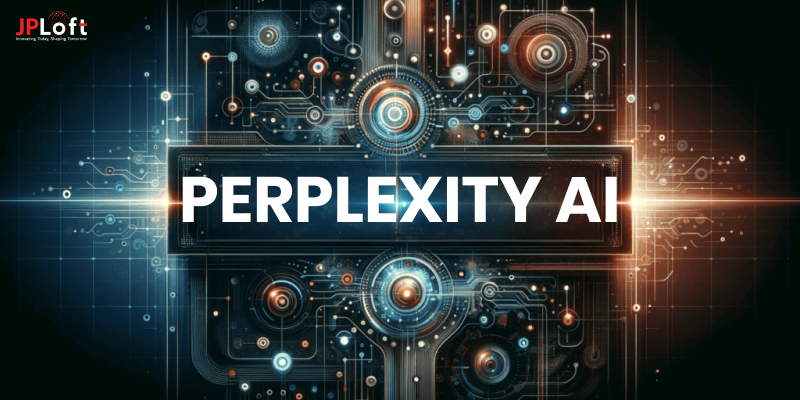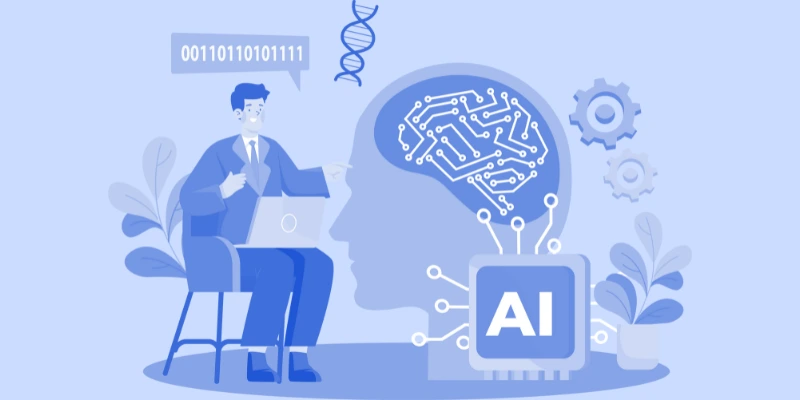Artificial Intelligence (AI) is making its presence globally and being utilized by various industries at national and international levels. This innovative yet advanced technology makes people's lives easier. AI is vital in generating intelligent systems, and power automation helps in prediction and decision-making processes. From virtual assistants to recommendation engines, AI companies are at the heart of many tools. However, many of us use it in our daily routines. However, understanding and using these models is an overwhelming task for non technical professionals. If you’re from a non- technical background, you can hire engineers that understand your work idea and what you're actually looking for .
In this guide, we'll discuss the realm of AI models, its market scenario, and ways to use AI models to improve your projects and business.
Market Insights: The Rise of AI Models
The popularity of AI models has seen exponential growth in recent scenarios driven by advances in machine-learning algorithms, the increase in computational power, and the abundance of data. According to market research, AI models are likely to hit $733.7 billion in 2027 in the upcoming years, which includes AI models playing an essential part in accelerating this expansion.
Many industries, such as finance, healthcare, manufacturing, retail, and entertainment, use AI models to gather valuable information to improve efficiency, increase customer experiences, etc. From personalized medical care to predictive maintenance, AI models are driving a range of applications, resulting in growth, competitive advantage, and business transformation.
The Future of AI Models
As we when we look the future in AI models, it offers endless options that are as follows:-
Federated Learning
Federated learning enables AI algorithms to be developed across various devices without compromising the privacy of your data. It's set to transform AI applications that run on devices with edge capabilities.
Self-Supervised learning
Self-supervised learning lets models learn from unlabeled data and reduces the need for lengthy labeling. This trend will create new possibilities for AI.
Explainable AI Models
AI is advancing into critical areas like finance and healthcare, and the need for explicable AI models becomes crucial. Models that justify their decisions will become more popular.
AI for Edge devices
Smartphones and IoT sensors are edge devices getting smarter by incorporating AI models. This innovative technology, designed specifically for edge devices, will play an essential part in shaping our connected world.
Also Read: Challenges and Opportunities in Blockchain, AI & IoT Software Development
How Artificial Intelligence Model Development Company Help Businesses?
The value of AI Models in Business Data, Artificial Intelligence, and machine learning is increasing in the business world. Data is generated rapidly, and businesses rely upon AI algorithms to find important data when applying actual challenges. Holding years of experience, Artificial intelligence engineers are capable enough to complete or resolve tasks that are impossible or time-consuming for human beings. We have identified a few important ways to apply AI models can impact business:
-
- Data collection to build AI models
- Make use of AI models to generate fresh data
- Apply AI models to comprehend the data
- Utilize AI models to automate your tasks. Let's look at these strategies.
Gather data to build AI models.
The capacity to gather data for training is crucial in situations where competitors do not have limited access to data or if it is difficult to acquire. Data allows firms to develop AI models continuously and retrain (improve) the existing ones. There are numerous ways to gather data, such as scraping it off the web and using cameras or sensors. Access to massive amounts of data facilitates efficient development.
AI models can be utilized to generate new data.
This model can generate new data, more or less similar to the training data, including generative Adversarial Networks (GAN). Innovative generational AI models can generate images that help photographers look like art or photorealistic (such as the DALL-E2). AI models can be utilized to create entirely brand-new sets of data (synthetic information) or artificially increase the size of existing data (data enhancement) to make more efficient algorithms.
AI models can be utilized to study data.
Model inference is the method of using an algorithm to predict the output of a particular input. It is accomplished by applying new information (existing information or sensor data) that the model has not "seen" before and then analyzing the results. AI applications typically employ model inferences to "apply" a trained model to business tasks, such as person recognition or tracking and detecting objects in the video stream.
Models of AI can be utilized to automatize jobs.
AI models are incorporated into pipelines in the business world and other industries. A pipeline comprises various steps, including data acquisition transformation, analysis, and output. In computer vision, a vision pipeline collects the video stream and applies image processing before adding individual images to the DL model. If used in manufacturing, for instance, it can be utilized to automate visual inspection or automate the counting of objects in bottles placed on conveyor belts.
In the end, AI models can help companies improve their efficiency, be competitive, and be profitable by allowing them to make better choices by analyzing data. Shortly, AI models will likely be more significant in the business world as businesses embrace them to gain an advantage. We will then review the most popular, widely used AI models you need to know. Then, we'll review the entire list and explain them in detail.
Most Popular AI Models
In this section, we are going to discuss the most popular models that are commonly used in AI. However, AI companies will help you to understand each model and let you know which suits your requirements. Following are most popular AI models:-
Deep Learning Models
Based on the human brain, the models comprise many different layers of artificial intelligence interconnected to a web. They are particularly useful when the operation relies on a large amount of data, and there is an imperative to comprehend intricate patterns that are present in the information.
Natural Language Processing
Natural Language Processing models, specifically designed to understand and process human language, include a wide range of tasks. These include machine translation, which transforms human language into machine speech, sentiment analysis, and text summarization. These are built on machine learning models used in artificial intelligence.
Computer Vision Models
AI models have been specifically designed and created to comprehend and process visual information. Based on huge datasets of video and images, they are able to perform various tasks previously restricted to humans. Computer vision models can do tasks like image recognition, object recognition, facial recognition, tracking of object motion, and a host of other tasks.
Reinforcement Learning Models
They learn by trial and error by interacting with the environment and gaining rewards for desired behavior. They are utilized in various games, robotic controls, and training for autonomous vehicles. This is why they are thought to be the most sophisticated and effective AI models.
Generative AI Models
The models that generate the data are the ones that create. They create new data that is similar to existing data. GANs (Generative Adversarial Networks) are an example of this, and they are used to create real-looking images and videos.
Transformers
Transformer models, such as BERT, are revolutionizing language understanding. They're the communication engines that help machines comprehend human language more effectively. Chatbots and translation systems heavily depend on these systems.
Benefits of AI Models: Driving Innovation and Business Value
The introduction of AI models can provide a myriad of advantages across a variety of domains, which allows businesses to:
Enhanced Decision-Making
AI models can provide important insights from information, making it possible to make informed decision processes. Whether it's about predicting customers' preferences or enhancing supply chain operations, AI-powered analytics allow businesses to keep ahead of the curve.
Increase Productivity and Efficiency Automation aided by AI models can streamline repetitive tasks, allowing personnel to focus on more strategic endeavors. From automating the processing of documents to optimizing the allocation of resources, AI-powered efficiency gains translate into substantial savings in costs and productivity gains.
Personalize Customer Experiences
AI models allow customized recommendations and personalized experiences based on your individual preferences and behaviors. Whether it's suggesting products, content, or services using AI, personalization increases customer satisfaction and loyalty.
Drive innovation and Creativity.
Experimentation companies to investigate new possibilities and ideas for letting know about results From creating innovative products to optimizing processes, AI-driven innovation helps businesses stand out from others in a competitive market and increases business performance.
Overview of the Most Important AI Model Types In the next step, we will look into those AI techniques and highlight their most important characteristics.
Large Language Models (LLM)
Large Language models of AI can be used to generate, understand, and interact with human language. These types of models are trained on enormous amounts of text data used for natural language processing (NLP) tasks such as translation, text generation, summarization, and question-answering. OpenAI's Generative Pre-trained TransformerChat GPT-3.5 or 4 is a frequently used software that renders answers using deep learning techniques. It is often used in neural networks, allowing one to analyze and predict language patterns for producing remarkable coherent and contextual text.
Deep Neural Networks or DNN
Deep Neural Networks (DNN) are artificial neural networks featuring multiple layers between input and output layers that resemble those found in human neural networks, drawing inspiration from them for use as artificial neurons. This is one of the AI models helping to find applications across many areas, including voice recognition, image recognition, and natural language processing (NLP).
Decision Trees
Within the field of Artificial Intelligence, the Decision Tree (DT) model is utilized to arrive at an answer based on evidence from prior decisions. An easy, efficient, and extremely well-known model, the Decision Tree is named due to the way in which the data is split into smaller pieces, like the tree's structure. This model can be used for both classification and regression problems.
Linear Discriminant Analysis (LDA) is a branch of the Logistic Regression model. It is utilized only when two or more classes need to be separated from the output. This model can be useful for various tasks in computer imaging, medicine, etc.
Naive Bayes
This is an easy yet effective AI model that is useful in solving many complex issues. It is based upon the Bayes Theorem and is mainly utilized for testing classification. The model is based on assuming that the presence of a specific feature is not dependent on the presence of other features. Because this assumption is not valid, it is called "naive". It can be used to perform multi-class and binary classifications. Its applications include classification of medical data and filtering out spam.
Support Vector Machines
Support Vector Machines, also known as SVM, are rapid and efficient models that help analyze small amounts of data. They are a good choice for the binary problem of classification. In comparison to the latest technologies, like artificial neural networks, SVM can be faster and more effective when working with a set that is limited in sample size, for instance, for text classification. It is a supervised ML algorithm that is employed for outlier detection and regression problems.
Learn Vector Quantization
Learning Vector Quantization (LVQ) is a form of Artificial Neural Network that operates on the winner-takes-all principle. It analyzes information by creating an array of codebook vectors that are later used to categorize other unknown vectors. LVQ is utilized to solve multi-class classification issues.
K-nearest Neighbors
The k-nearest Neighbors (kNN) Model is a basic supervised ML model used to solve classification and regression problems. This algorithm operates by assuming that similar things (data) are located near each other. Although it's an effective model, one of its biggest drawbacks is that it is reduced with an increase in the volume of data.
Random Forest
Random Forest model of Houses for resolving regression and classification problems. It has multiple decision trees and then makes the final prediction using the bagging technique. To make it easier, it creates a 'forest' using multiple decision trees, each of which has been trained on various data subsets and later on combines the results to produce more precise predictions.
Linear Regression
This is a model widely used in statistics, which is based on the concept of supervised learning. The principal goal of this method is to discover the relationship between input and output variables. In simpler terms, it determines the value of dependent variables based on an independent variable. The linear regression model is extensively employed in various sectors, such as retail, banking construction, health insurance, etc.
Also Read: The Importance Of AI In Web Development
Practical Tips for Using AI Models Effectively
Although the advantages of AI models are evident, using them effectively requires proper planning and execution. Here are some valuable suggestions to think about:
Define clear objectives
Clarify your goals, what you want to achieve from artificial intelligence, and the criteria for success in the AI project. It doesn't matter if it's increasing accuracy, cutting costs, or improving the satisfaction of customers by having a clear goal; having a clear view will ensure alignment and a clear focus.
Quality Data is Essential
High-quality data is crucial for training precise and reliable AI models. To guarantee the quality and accuracy of your data, invest in data collection, preprocessing, and curation.
Select the Best Model
Selecting the suitable AI model and algorithm depends upon your information and the specific issue. Try different algorithms and models to determine the most effective one.
Iterate and refine
AI applications are iterative in nature. Monitor your model's performance regularly and gather feedback from end users. Later, you can develop strategies to improve accuracy and adequacy over time.
Ethics
Keep yourself updated and aware of the ethical implications associated with AI models, such as fairness, transparency, and accountability. Check that your AI systems comply with regulatory agencies' ethical standards and requirements to limit risks and biases.
With these suggestions and the most effective practices, businesses can use AI models' potential to boost innovations, improve decision-making, and generate value for all stakeholders.
Conclusion
Undoubtedly, AI models are the core and the soul of innovative technologies. They've come quite a long way since their start and to revolutionize our world. However, with power comes a great responsibility. Ethics must be the primary consideration in our actions.
If you're an AI software engineer, you're more than only a model builder but a part of an entire community. A community that believes in the power of knowledge and trust and requires responsible AI development.













Share this blog